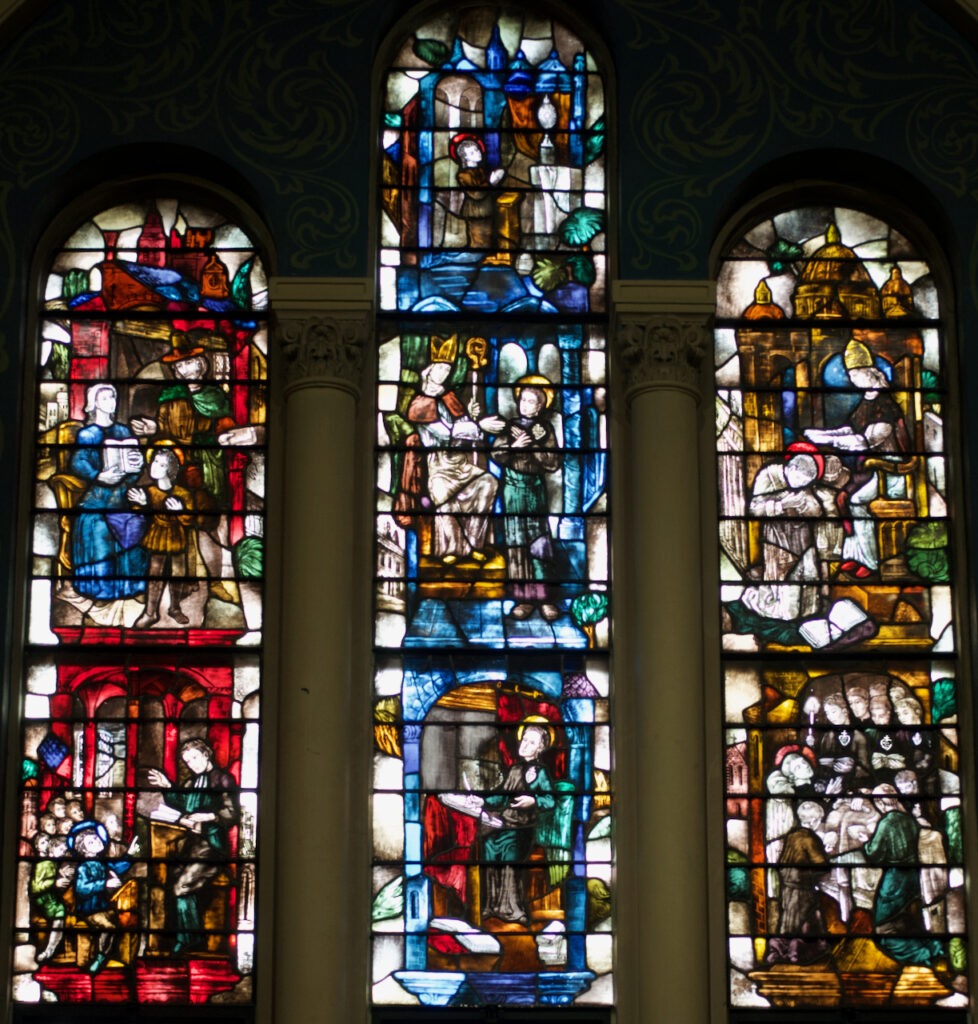
October 20 is the feast of St. Paul of the Cross, founder of the Passionist Congregation. The Passionists founded St. Joseph’s Monastery Parish and staffed it until 2014. The window is over the side altar dedicated to St. Paul of the Cross and is a triptych depicting important events in his life.
Born Paul Danei, in 1694, he lived his early life in Ovada, Italy. The left pane of the window pictures his education during these formative years. In the top image Paul is in his home with his mother and father, who are both holding books. His education began at home and surely included the development of his Catholic faith. In the lower image he is attending a parish school in Cremolino. His hand gesture suggests his interest in what he is learning as he interacts with his teacher. It is thought that Paul did not receive much formal schooling and was soon working in the family business. But it was during this time that God planted the seeds of His calling on Paul’s life. The red background in these images suggests the work of the Holy Spirit in Paul’s heart as he was growing up.
As a young adult Paul experienced God’s love in profound ways and dedicated his life to loving and serving God with his whole being. The middle pane of the triptych illustrates this period. In the uppermost scene he is praying before the Blessed Sacrament. He spent much time in prayer and had a series of experiences which drew him into a mystical union with Jesus, especially in His sufferings and crucifixion. He had a burning desire to share this reality with others through communal life and spread it to the world. This developed into realization that God’s desire was for him to form an order dedicated to Jesus in his Passion. The second scene is of Paul being clothed in a black habit by Bishop Gattinara of Alesssandria. On his habit is the Passionist sign, which Paul received in a vision from the Virgin Mary. The importance of Mary in Paul’s spirituality is suggested by the blue background in these scenes. The bishop is wearing a miter and holding a crosier, the symbols of his office and authority. From him Paul received permission to preach and teach catechism. He quickly had a profound influence on the spirituality of the communities in which he ministered. In the scene at the bottom of the pane Paul is writing the Rule for the order he hoped to found. The red in the image suggests the inspiration of the Holy Spirit as he writes. Green often is a symbol of hope, and perhaps the green in this image suggests his hope for the future order. He remained faithful to this hope even when his efforts bore no fruit.
The final pane of the triptych depicts Paul’s developing relationship with the institutional Church. The background of this pane is a rich golden brown. Although Paul had permission to preach, to minister to the sick, and to gather others around him, it was many years before his new order would be approved. In the top scene, having completed studies for the priesthood, Paul and his brother, John Baptist, who had accompanied him as he attempted to found his order, are ordained by Pope Benedict XIII. In 1741, Paul received the Pope’s blessing to establish the Discalced Clerics of the Passion. It then took time for like-minded men, who were willing to live by the strict Rule of the order to join him. The Rule, written by the mystic Paul, was revised to provide the structure necessary to govern communal religious life. The Passionists were now an official part of the Church.
By the time of his death at age 82, the order was well established, sharing the love of God revealed in Christ’s Passion with the world. The final scene in the window is of the death of Paul on October 18, 1775. Paul is holding a crucifix and is surrounded by his associates. Green is again a prominent color. Paul lived to see his hope fulfilled in his order; now that hope would be carried by others into the future. Those around him have open prayer books and one is holding a lit candle, the light of Christ. Jesus will receive Paul’s soul into eternal life and will guide his order as they continue to share the Passion of Christ with a world often torn by war, division, poverty, and sickness, bringing a message of reconciliation, healing and peace.
On this feast of St Paul of the Cross this window can help us reflect on how God may have been active in our lives, even from our earliest childhood. How did we first know God? How has God guided our lives, even when we may not have been aware? How can we make prayer to Mary be a part of our spirituality? What hope has God planted in our hearts and how can we be faithful to that hope? It can also inspire us to reflect on the Passion of Christ and the charism of Paul. May we ask God to help us see Jesus in everyone we meet. May we especially see Him in those who are vulnerable and in need, and in those who are different from us. May we ask God to help us be a source of healing, reconciliation, and peace to those around us, and in the wider world.
Reference
Cingolani, Gabriele. (1994.) St. Paul of the Cross. Passionist Publications.